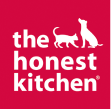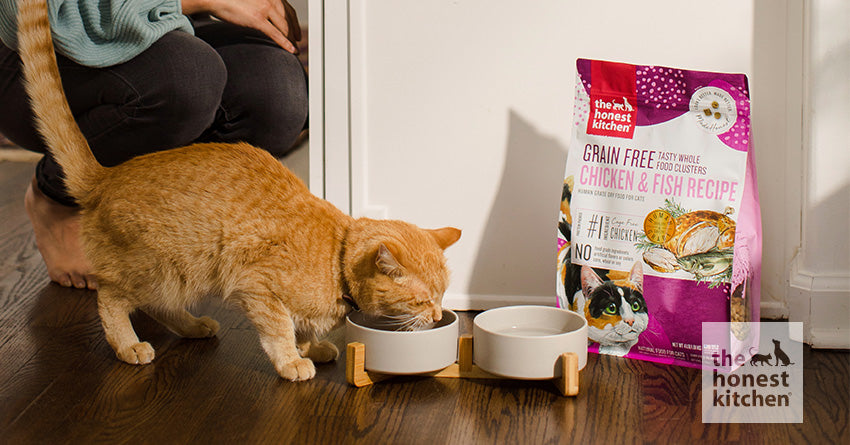High-quality human grade pet food is one of the best things you can feed your feline friend. One of the main reasons for this is that human grade cat food is produced to meet much more rigorous ingredient standards than feed grade cat food (which is what the vast majority of cat food is). As a result, human grade cat food typically has better nutritional value and more health benefits for your cat, and you should start to see a difference in your cat after they start to eat a healthier diet.
In this article, we’ll cover what exactly human grade cat food is, the differences between human grade cat food and feed grade cat food, and then we'll dive into how human grade cat food can benefit your cat’s health.
How The Honest Kitchen Spearheaded Human Grade Standards With the FDA & USDA
Human grade pet foods have become popular in recent years, but the CEO and Founder of The Honest Kitchen, Lucy Postins, produced human grade pet foods long before the hype. In fact, The Honest Kitchen was using the term “human grade” for years before being approached by the U.S. Food and Drug Administration (FDA) and the U.S. Department of Agriculture (USDA). These agencies asked us to prove that our food was indeed safe for human consumption based on a list of strict regulations set by the FDA. We're proud to say that The Honest Kitchen met these criteria, which is how we set the standard for the government regulation of human grade pet food.
The Honest Kitchen maintains the highest quality and safety standards in their pet foods to this day. Our food always includes high-quality meats that never include meat by-products, otherwise known as "4D" (dying, dead, disease, or disabled) meats. In addition to following the FDA’s regulations, The Honest Kitchen also maintains a high standard of quality assurance by testing at an independent third-party laboratory to make sure each batch of food is free of pathogens like E. coli, salmonella, and listeria.
Safety Standards of The Honest Kitchen’s Human Grade Pet Food
The Honest Kitchen’s foods are made with three tiers of safety to reach human grade status.
This stage includes sticking to the requirements for human foods by the FDA and USDA, and stocking ingredients for pet foods with a lot-specific certification of analysis (COA) that then undergoes testing to verify chemistry, physical, and microbiological requirements.
This stage includes completing documentation that shows the human edible status, states the country of origin of the ingredients, outlines the COS parameters, and documentation for The Honest Kitchen’s non-GMO claim.
Lastly, the finished pet food is audited by a third-party food safety expert to ensure the pet food company follows good manufacturing practices, as well as to confirm that the pet food follows the FDA regulations for human food.
Though The Honest Kitchen goes above and beyond what the government requires of human grade pet food, the complete, specific regulations from the FDA can be found in the FDA 21 CFR 110, Current Good Manufacturing Practice in Manufacturing, Packing or Holding Human Food.
The regulations revolve around ensuring that pet food that is labeled “human grade” is actually produced in a factory for human food and the ingredients all meet the “safe for human consumption” standards. This means that at every step of the food-making process, the ingredients must be edible for human consumption. Additionally, the factories where the human grade cat food is made must be USDA-inspected facilities for human food — which means they must maintain over 100 safety standards.
The criteria outlined in the FDA 21 CFR 110 are difficult to maintain, which is why so few pet food brands are truly human grade. It's a long, expensive process that requires a ton of documentation, follow-up, and maintenance. As a result, most commercial pet food brands don't attempt to meet human grade standards.
Human Grade Food vs. Human Grade Ingredients
When choosing your cat's food at the grocery store, be on the lookout for cat food labels that say something along the lines of, “made with human grade ingredients.” This is a sneaky way to give the appearance that the food is human grade, but in reality, it means it likely isn’t a food that meets the quality and safety standards required to use the actual term “human grade.”
Other pet foods like to tout “real” or “natural” ingredients, but this has no impact on whether or not the product is human grade.
For example, many popular pet food brands advertise “real meat” as the first ingredient in their cat food recipes. Technically, this is often true. However, if you continue reading down the ingredient list, the second and third ingredients are likely meat meals. Not only are meat meals never considered human grade, but they’re also highly processed and not as nutritious for your pet.
By contrast, The Honest Kitchen offers chicken and turkey dry cat food but the list of ingredients starts with turkey, chicken, peas, potatoes, eggs, lentils, and turkey liver — all of which are human edible and human grade — and made in a human food facility that meets over 100+ safety standards to ensure your cat is getting a safe, nutritious dinner.
The Key Differences Between Human Grade and Feed Grade
If a cat food is not labeled human grade, it is considered feed grade. The biggest difference between human grade cat food and feed grade cat food is the number of regulations each type of food must follow. As mentioned above, the FDA regulates any type of human edible foods, but for feed grade animal foods, regulations are set by the Association of American Feed Control Officials (AAFCO).
AAFCO has requirements about which types of ingredients a company can put in pet food products and also has extensive labeling requirements. However, the requirements for types of ingredients in pet food are laxer than in human grade pet food. For example, the types of meat allowed in feed grade pet food range from poultry and beef to meat by-products, meat meal, and animal by-product meal, according to the AAFCO.
The other main differentiator between human grade and feed grade pet food is the environment in which the food is created: a human food facility or an animal feed factory. Each type of facility has different standards, and human food factories have more stringent standards to abide by.
Is Human Grade Cat Food Better Than Feed Grade Cat Food?
Though human grade cat food can have excellent nutritional benefits for your pet and is widely accessible, it’s not necessarily the be-all and end-all: Ingredient quality is an important factor.
There are several ingredients in feed grade cat food that are technically edible for humans, but offer little nutritional value. Some of these ingredients can include corn, wheat, soy, and binders like potato starch.
In some cases, these ingredients can even lead to gastrointestinal issues, and can contribute to empty calories — a concern for anyone trying to help manage their cat’s weight.
Before deciding to switch to a human grade pet food, check in with your vet — they will know best whether it’s a good idea to make any significant changes to your cat’s diet.
4 Reasons To Consider Switching to Human Grade
As noted, human grade cat food contains high-quality ingredients and is a tasty option for even the pickiest of eaters, but the health benefits are also abundant. Human grade cat food can help your cat’s digestive health, give them healthier skin and fur, boost their energy levels, and support their joint and bone health. Let's explore these health benefits in greater detail.
1) It Can Aid In Your Cat’s Digestive Health
Like humans, much of cats’ overall health can be linked to their gut health. Also just like in humans, food that is full of fillers can upset your cat’s stomach, causing poor digestion, diarrhea, or constipation. Because human grade cat food uses the cleanest ingredients and minimal fillers, a cat eating human grade food will be supporting the natural good bacteria in their gut to thrive, thus, creating a happy belly. If you’re looking for belly-friendly human grade food options for your cat, look into The Honest Kitchen’s nutritious bone broth, turkey stew toppers, and pate to satisfy your cat’s needs.
2) It Can Encourage a Healthy and Shiny Coat
Amino acids and fatty acids are vital parts of cats’ diets. They support a lot of aspects of your cat’s health, but their fur is of the utmost importance. Specifically, antioxidants, omega-3 fatty acids, linoleic acid, and zinc are great for keeping your cat’s coat silky smooth. These amino and fatty acids can be found naturally in high-quality red meat, like beef and lamb, as well as in carrots, sweet potatoes, and pumpkin.
3) It Offers Easily Digestible, High-Quality Proteins
Because cats are obligate carnivores, a diet that consists of high-quality protein and low carbohydrate content (not necessarily grain-free) can lead to higher energy levels in your cat and encourage a healthier weight.
Even if you are feeding your cat a high-protein, low-carb diet right now, you may be surprised to find out that the source of the meat in feed grade cat foods can be questionable at best. Even more, the food may be full of unhealthy filler grains. In human grade cat food, the types of meat used are extremely high quality, meaning they are less processed and contain more vital nutrients your cat needs to thrive. Another bonus: High-quality meats — like chicken liver, chicken breast, and turkey — have naturally-occurring taurine, an amino acid that is vital for a cat’s health. Taurine supports vision, digestion, heart function, and healthy immune systems. Without taurine in their diets, cats can suffer from serious health problems like feline central retinal degeneration or dilated cardiomyopathy.
4) It May Help Support Your Cat’s Joint and Bone Health
As cats age, their joints and bones age, too. Some cats may even develop arthritis. That’s why it’s important to ensure your cat gets the essential fatty acids in their diet to support their joints and bones. Specifically, fish oil and omega-3s can help aid in this. Omega-3 fatty acids can be found naturally in fish, vegetable oils, nuts, and flax seeds. Flaxseed oil is actually a key ingredient in many cat foods from The Honest Kitchen, including our wet cat food and kibble-like dry cat food.
Switch to The Honest Kitchen’s Human Grade Cat Food Today
Like any pet owner, you want the best for your furry friend, so why feed them anything less than the best human grade cat food from The Honest Kitchen? Because The Honest Kitchen was the first official human grade pet food company, you can feel confident that your cat is eating the best quality ingredients that will support their overall health, longevity, and wellness. Check out The Honest Kitchen’s collection of cat foods and discover what switching to THK can do for your cat's overall health.

